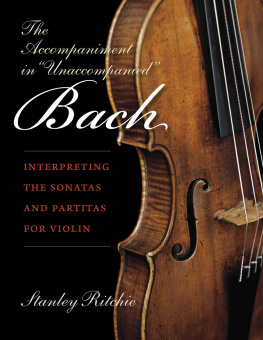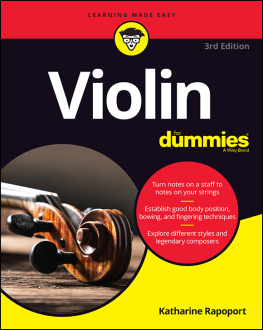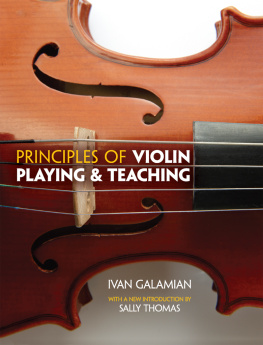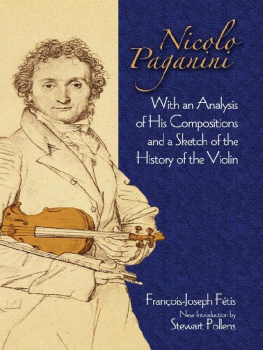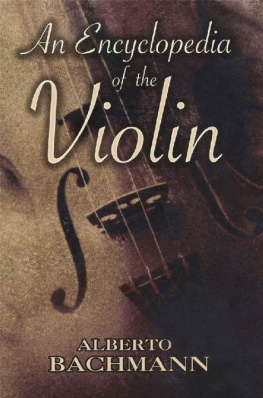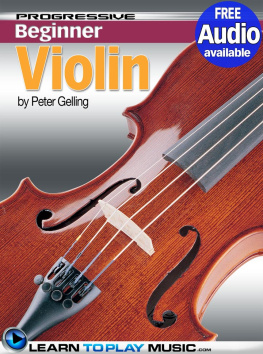Violin
Master Works &
Their Interpretation

Violin
Master Works &
Their Interpretation
LEOPOLD AUER
WITH A FOREWORD BY
Frederick H. Martens
Dover Publications, Inc.
Mineola, New York
Bibliographical Note
This Dover edition, first published in 2012, is an unabridged republication of the work originally published in 1925 by Carl Fischer, Inc., New York.
Library of Congress Cataloging-in-Publication Data
Auer, Leopold, 1845-1930.
Violin master works and their interpretation / Leopold Auer ; foreword by Fredrick H. Martens.
p. cm.
This Dover edition, first published in 2012, is an unabridged republication of the work originally published in 1925 by Carl Fischer, Inc., New York.
eISBN-13: 978-0-486-32110-3
1. Violin musicAnalysis, appreciation. I. Title.
MT140.A85 2012
787.2dc23
2012014000
Manufactured in the United States by Courier Corporation
49911101
www.doverpublications.com
FOREWORD.
For the violinistas for every musical artistinterpretation, the living soul of playing, is the touchstone of his art. When he can translate in tone the thought, the spirit, the beauty of the music he plays so that it is revealed to his auditors with the clarity and beauty its composer intended, he is truly an interpreting artist.
The formulating of the how of interpretation, even with regard to those masterworks of the violin which every advanced student must know, is not so easy. As the author of this volume points out in his Introduction, the student himself must be equipped with a very definite quota of technique, musical intuition and good taste before he can hope to derive major benefit from the detailed interpretative consideration of any important work.
It may safely be said that there are only a few individual figures in the violin world whose outstanding achievement and authority would secure for their views that general respect which would make such consideration valid. For the interpretation of a musical composition always remains to such a degree an individual and personal matter, that only the utterances of an interpreter whose experience and authority were unquestioned would secure for his conclusions the practical acknowledgement which would make them most widely useful and beneficial.
That the aesthetic and practical views of the man who has formed that brilliant galaxy of contemporary violin virtuosos known as the Russian school, anent the interpretation of the master works of the violin are invaluable to every student of the instrument may be taken for granted. And yet, with the instinctive modesty common to those whose achievement is real, Professor Auer at first hesitated to commit himself to a book on a subject which so greatly interested him and which he was so uniquely fitted to consider.
The writer, with whom Professor Auer discussed the matter when the subject of the present volume was mooted, was instrumental in overcoming his first hesitation and this may have led Professor Auer to suggest his Foreword for a volume which proves how adequately its author has handled his delicate and elusive subject. It was a request with which the writer was happy to comply, since it has given him an opportunity of outlining the works outstanding qualities.
Some will be so self-evident to the student that they do not call for extended consideration. It is at once clear that the author is modest. He brings no tablets from the Mount. He presents his own opinions with respect and tolerance for those of others. He is neither an individualist nor a traditionalist, but renders unto artistic individuality and tradition that which is due to each.
Then, too, the plan of the work is elastic. From the great body of violin literature Professor Auer has chosen for detailed interpretative analysis and discussion some seventy odd major compositions; in practically every case living works, compositions which form a vital part of the existing violin repertoire. They follow each other in an informal chronological sequence and, though he is careful to establish the character of the individual work and of its period, the author has eschewed extended biographical or other digressions not bearing on the subject. After all, he remarked to the writer, there are enough good biographical dictionaries and individual biographies to which any student may refer. I feel that my book will be practically useful in direct proportion to the fullness of detail with which it considers its subjectthe interpretation of the masterworks written for the violin.
And with due regard for the personal equation in interpretation, which Professor Auer never forgets, he has concentrated on analyzing the masterworks of violin literature in clear, practical expositions of how each should be played in order to do justice to the work and to the player. Noteworthy are the invaluable hints and directions regarding the technical minuti of interpretation: special bowings; mood and tempo variants; artistic effects; methods of individual procedure which Professor Auer uses with his own pupils; individual cuts which enhance the audition of a work on the recital stage, etc., all drawn from the authors rich fund of artistic experience. And in many cases the author supports his interpretative views by citing the actual opinions and procedure of such composers and artists as Joachim, Vieuxtemps, Wieniawski, Saint-Sans, Wilhelmj, Sarasate, Sivori and others, whom he heard play most of the works to be considered and with whom he discussed them.
A large number of musical examples, covering all the detail of the authors interpretative directions make the niceties of tempo, dynamics, special bowings, fingerings, etc., clear to the student beyond any manner of doubt; and as a pendant to the more important individual works considered, a concluding chapter develops the authors ideas with regard to Transcriptions and Musical Memory, two subjects intimately linked with his theme; the first with the repertoire, the second with its presentation.
The present volume is the third which its author has written. From the point of view of the student it is, perhaps, the most valuable. The values of the delightful My Long Life in Music, in which Professor Auer has told the story of one of the most interesting of musical careers, are more purely literary and cultural. Violin Playing as I Teach It is devoted to the fundamental practical and aesthetic aspects of the art. But the Violin Master Works and Their Interpretation might be called the authoritative text-book of a master on interpretation whose teachings and influence have been revealed by pupils and interpreters such as Elman, Heifetz, Zimbalist and a score of others. And there can be no question but that the student who marks, learns and inwardly digests it will realize its authors hope that he will find himself better able to express the soul, the thought, the spirit of the great creators of all that is finest in violin music.
FREDERICK H. MARTENS.
INTRODUCTION.
To express the inexplicable so that it can be understood, to define and segregate the experiences and reactions of musical emotion so that they may be grasped by the invisible eye of the spirit, is not easy. My aim is to offer the young violinist and student a legacy, a tangible evidence of my long years of experience as an interpreting artist and a teacher of the classic literature of the violin, with regard to the interpretation of the great works of the ancient as well as the modern masters.
In my opinion the question of musical style is one that can be considered only from a purely individual standpoint: it is not possible to determine
Next page

